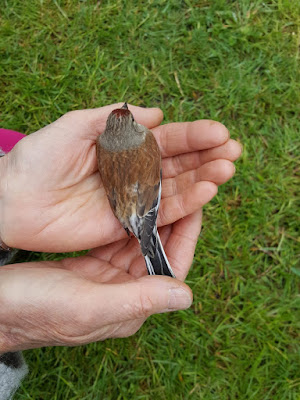The other ringed plover stayed sitting on her nest about twenty metres further along the beach. It would seem both pairs have laid about the same time as each other as there was no sign of any nesting last week. Another ringed plover was seen feeding on nearby mud, a presumed partner of one of the sitting birds. Unfortunately both nests are located in very vulnerable places on the beach where lots of walkers and dogs pass.
At the nearby saltmarsh pools near the Golfhouse, one avocet is still sitting on her nest with three other avocets feeding in the water. Two redshank were also present and might nest nearby later. On the park's grazing fields four largish lapwing chicks from one brood were still present, another female seemed to be squatting low to shelter some young chicks from the cold and another lapwing was seen incubating amongst some daisies. A pair of Canada geese and five shelduck were also noted.
On the mudflats were forty oystercatchers and five little egrets while in the river were a pair of common terns and five great crested grebes.
The sand martins were busy at their colony in the cliff at the country park with at least ninety holes seemingly freshly dug out and in use. Around fifty sand martins were flying about the beach and nearby park, while five swifts were seen over the park too.
The song of the nightingale was heard again coming from the copse at the back of the pond, the bird has now been present for a week now. Seven blackcaps were singing in the country park where the population has increased in recent years - twenty years ago there were only eight blackcaps counted in the whole of East Mersea. Other warblers noted at the park and nearby hedges were two sedge warblers, three reed warblers, two Cetti's warblers, 12 whitethroats, two lesser whitethroats and two reed buntings.
A flock of fifty linnets was feeding in a horse paddock to the north of the park.
In West Mersea the first swift was seen inside the swift nestbox on Andy Field's house in High Street North on Wednesday. A red kite flew south over Ian Black's house in Mersea Avenue on Wednesday afternoon, while earlier a buzzard was mobbed by crows as it flew west along Firs Chase to the Hard.
A green hairstreak butterfly was enjoying the warmth in the Firs Chase garden on Tuesday 18th, occasionally flying off to chase a holly blue away. An orange tip and small white were also seen in the garden.
A slow-worm was spotted in the Firs Chase garden under the tree where the green hairstreak was basking.
The wheatear was still on the washed up dinghy called "Get Wrecked" beside the Strood seawall on Tuesday 18th having been here for a few days. Other birds noted were three buzzards, cuckoo, 12 swifts, two common terns, two grey plover, whimbrel and six linnets.
Jonathan Bustard watched a spotted flycatcher near Feldy View and a marsh harrier over the Strood channel early Tuesday afternoon.
At Cudmore Grove on Tuesday morning, Andy Field reported the nightingale singing near the park pond, cuckoo, two largish lapwing chicks and two new small ones, 50 sand martins in and around the cliffs, two pairs of avocets on the Golfhouse pools, the female kestrel in the nestbox, a buzzard and a marsh harrier.
Around fifty sand martins were seen at the park by Andy on the 18th.
On Monday 17th this male yellow wagtail was feeding beside the Strood seawall as were four others. The sunny weather saw several birds of prey take to the wing with eight buzzards and two marsh harriers seen, also two sparrowhawks and a hobby flashing low past the Dabchicks and another distant hobby circling and feeding over Old Hall marshes.
Also seen from the Strood seawall on Monday were two barnacle geese flying north-east over the fields, three brent geese, two gadwall on Ray Island, a pair of mute swans, two grey herons while along the channel were two whimbrel, curlew, three dunlin, and two common terns. Small birds noted were a singing corn bunting, four reed warblers, lesser whitethroat, whitethroat, cuckoo, 15 swifts and eight house martins.
The rusty-breasted swallow was perched on wires next to the Dabchicks sailing club, close to where his mate is nesting in the old garage.
This colourful male linnet was photographed by Michael Thorley in the greenhouse in his East Mersea garden near Meeting Lane on Monday 17th.
Sarah had found the linnet a bit stunned in the greenhouse. There was a female linnet also in the greenhouse which was sadly found dead.

















No comments:
Post a Comment